GlobeNewswire reports that the global Business Intelligence (BI) market size is projected to grow from USD 36.82 billion in 2025 to USD 116.25 billion by 2033. This unprecedented growth is forecasted to happen as more organizations discover that BI best practices drive the performance of the business and sharp decision-making processes. In fact, according to Keevee, companies that prioritize data-driven initiatives are 23x times more likely to acquire new customers than organizations that don’t!
However, to reap all the benefits, a comprehensive business intelligence strategy needs to be implemented to ensure the best results of this initiative. That’s why in this article, we will discuss best practices in business intelligence strategy development, determining how a proficient vendor approaches this task.
Critical Reasons to Have a Business Intelligence Implementation Strategy
Organizations in seemingly every industry today generate massive amounts of data that come from their operations, related platforms, and IoT devices. Business intelligence strategy helps to consolidate valuable information into a single, trustworthy source of truth. However, this collected data may have issues regarding inconsistencies or duplications. So, with business intelligence strategy best practices it is possible to establish data governance, ensuring that decision-makers rely on clean, trustworthy data.
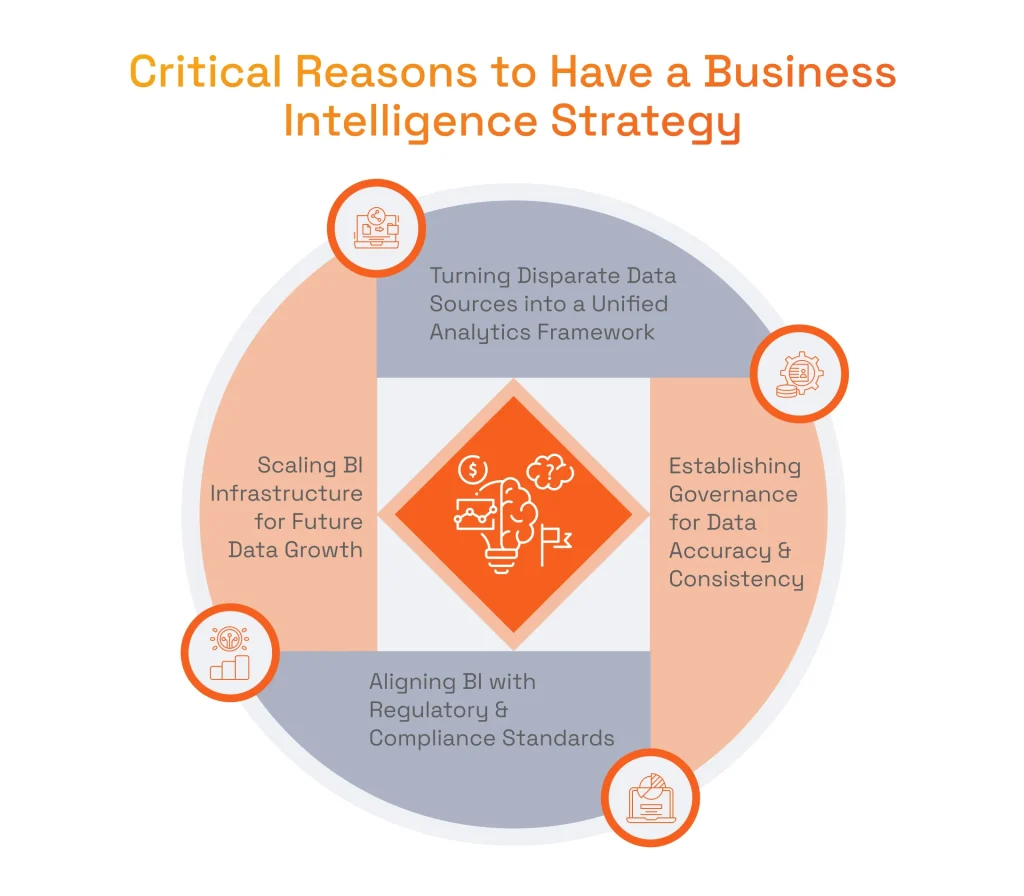
Having a BI strategy in place is especially important for regulated industries like Healthcare, Finance, and eCommerce. Failing to comply with GDPR, HIPAA and other industry-specific regulations leads to devastating consequences, including fines and unrepairable reputational damage among the clients. Having a proactive BI strategy allows an organization to integrate compliance measures to ensure data handling according to all requirements.
In addition, a Business Intelligence strategy serves as a far-reaching roadmap for scaling BI infrastructure in response to the future data volume increase. With the growth of the business, the volume of data increases accordingly, requiring a powerful analytics solution that can be scaled. A thought-out enterprise business intelligence strategy brings in AI-driven architectures based in the cloud, able to handle Big Data analytics and support future integrations.
Business Intelligence Strategy and Roadmap: What’s the Difference?
Before moving any further, let’s clear some misconceptions business owners frequently face when starting to develop their strategic vision for business intelligence implementation.
Business Intelligence Strategy Example
BI strategy is about the destination, the long-term vision, and the goals of using technological initiatives to benefit an organization. A well-crafted strategy is closely aligned with business objectives and focuses on data-driven decision-making across departments, predictive analytics implementation, and improving data governance.
In a business intelligence strategy example, an organization may include the following components:
- Leveraging BI to determine patterns in customer behavior for personalized promotions
- Use AI to prevent stockouts
- Analyze historical data to forecast seasonal demand.
Business Intelligence Roadmap Example
A roadmap, in turn, outlines a high-level approach to the implementation. In particular, mentioning the sequence of initiatives and milestones required to achieve goals.
As a business intelligence roadmap example, here is what essential phases it typically includes:
- Phase 1 (0-3 months): Establishing a unified data warehouse and cleaning of historical data.
- Phase 2 (3-6 months): Developing real-time dashboards to automate reporting workflows.
- Phase 3 (6-9 months): Enabling self-service analytics for business users.
- Phase 4 (9-12 months): Setting up machine learning models for predictive insights.
Business Intelligence Plan
With a defined business intelligence strategy and roadmap, let’s look at the plan. A business intelligence plan contains even more details by outlining specific execution steps and may include:
- Specific deadlines for each step of the implementation
- Clearly defined roles and responsibilities for each expert
- Details on budget, including prices for software, cloud infrastructure, and training
Business Intelligence Template
Finally, a template is a structured document to guide and track BI implementation. Here is a basic example of a business intelligence template:
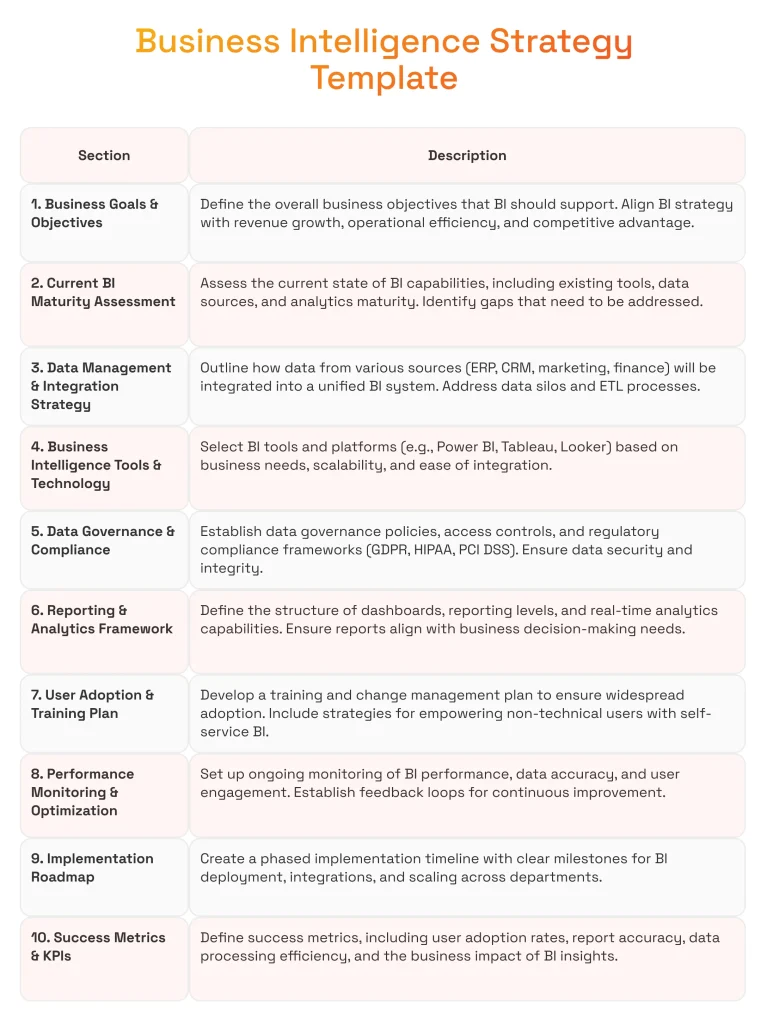
BI Strategy Main Components
Let’s continue our guide to business intelligence with a detailed description of each critical component of a strategy.
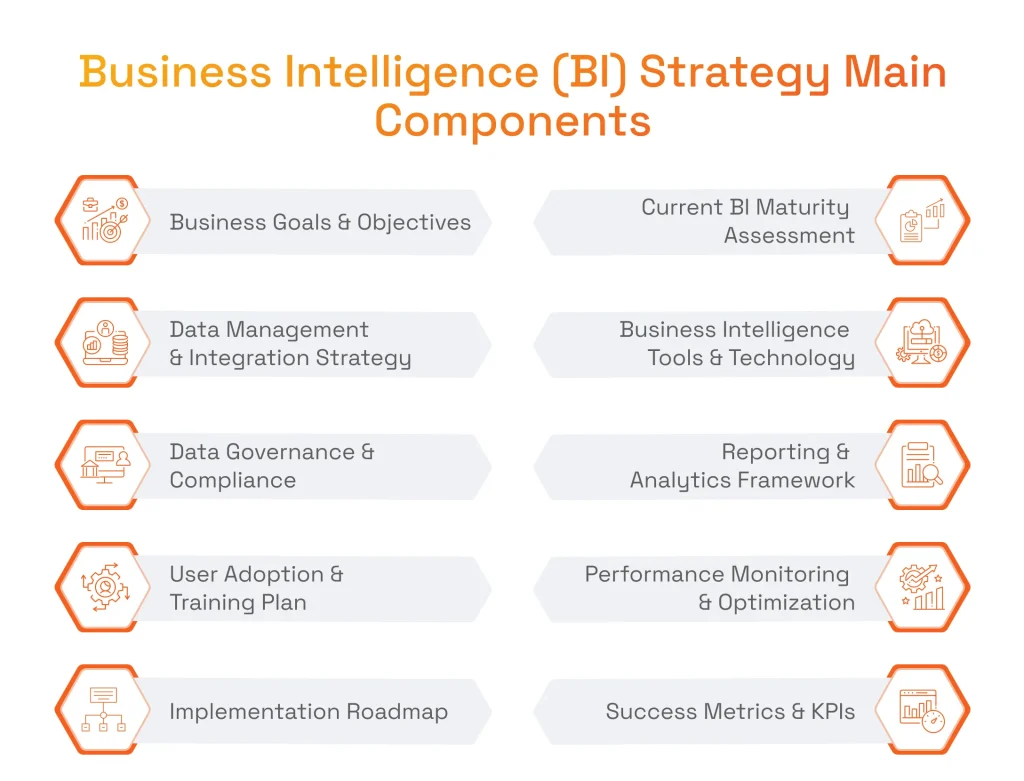
Business Goals & Objectives
This component defines the business results an organization expects to achieve with BI, for example, increasing revenue, improving customer experience, or optimizing operations. By aligning BI with business goals, it is possible to ensure tangible outputs of IT projects. The specific benefits of this include data-driven decision-making, justification of BI investments, and measurement of the effectiveness of BI systems.
Current BI Maturity Assessment
Another important component we should mention is the evaluation of the current capabilities of business intelligence, the quality of data, and adoption levels to determine the BI maturity of an organization. A realistic baseline with a knowledge of all possible gaps is essential for the identification of inefficiencies in data processes, as well as assisting in allocating resources to where they are needed the most.
Data Management & Integration Strategy
This strategy defines how the structured and unstructured data from entirely different sources will be gathered, cleaned, stored, and integrated into a unified analytics framework. By doing this, organizations will receive data consistency and accessibility with a holistic view of business performance and fast, accurate analytics.
Business Intelligence Tools & Technology
This component includes the correct selection of BI tools, databases, and cloud platforms, as well as AI-driven analytics solutions to match the needs of a business. The right choices in the technology stack lead to better scalability, automation, and smoother user adoption leading to improved and efficient data processing.
Data Governance & Compliance
The role of data governance is critical in business intelligence, as it defines the procedures and policies to help adhere to regulatory compliance. Organizations are at risk of security breaches and inconsistent reporting without proper governance practices. The tangible benefits of this component include ensuring data accuracy and minimizing cybersecurity risks, preventing fines and reputational damage from failing to comply with regulations.
Reporting & Analytics Framework
This framework defines how the data will be analyzed, visualized, and eventually reported, ensuring that actionable insights will be at the disposal of employees at all levels. A structured framework adds clarity and consistency of analytics to the overall BI initiative, as its tangible benefits include customization of dashboards for specific departments and providing automated reporting capabilities.
User Adoption & Training Plan
BI practices’ successful implementation relies heavily on how employees are trained to effectively leverage technological tools. Without proper employee training, business intelligence best practices become a waste of investments. Having a thought-out training plan for user adoption will help to maximize ROI, spread a data-driven culture within the organization, and reduce the rate of human error.
Performance Monitoring & Optimization
This determines the mechanisms for continuous tracking and improvement of BI processes based on the feedback of users and actual performance data. Without this component, even the best practices for business intelligence can quickly become outdated and fail to match the needs of a business. It is crucial to set up proper monitoring and optimization in order to have the ability to proactively adjust BI processes and identify the existing bottlenecks.
Implementation Roadmap
This roadmap includes a timeline-based outline of the deployment of other BI components. A structured roadmap business intelligence component helps stay within the budget, focus on priorities, and prevent delays. The main benefit of this component is a smooth implementation process without significant disruption.
Success Metrics & KPIs
This component allows measuring all elements responsible for ROI, adoption rates, and data accuracy levels. Without measurable KPIs, it is very hard to determine whether BI efforts are bringing any value at all. From the stakeholder’s perspective, this component justifies the continuous investments in BI initiatives.
Best Practices for Business Intelligence Strategy Development
How to do business intelligence? The following best practices will help you implement BI most effectively!
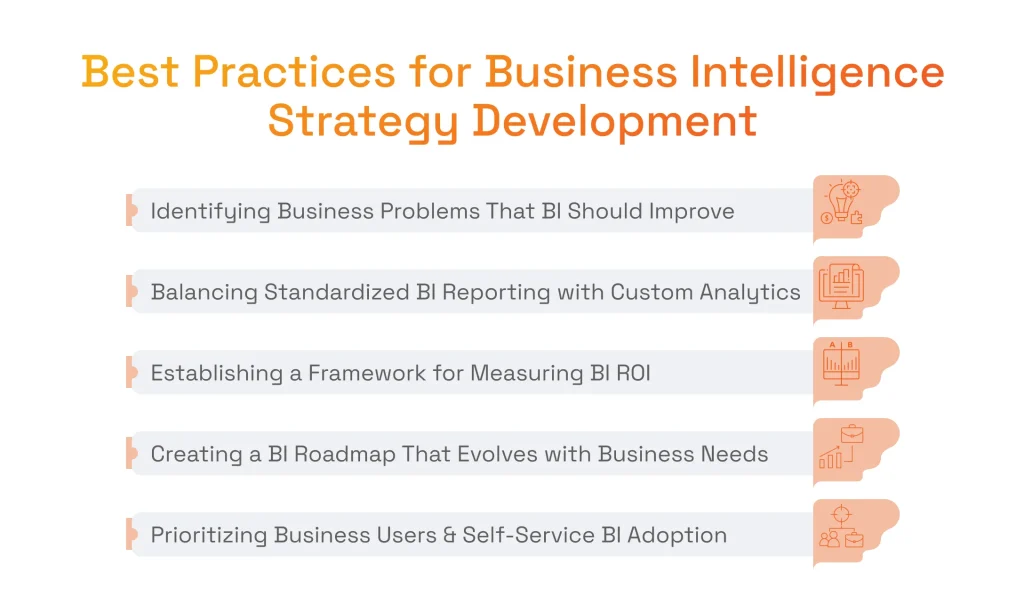
Identifying Business Problems That BI Should Improve
The first thing to do is to find out what specific business challenges BI should address, which may include operational inefficiencies or customer churn. Aligning BI objectives with strategic goals is the only way to ensure relevance and measurable impact. Business needs should always be over the technology-first approach.
Balancing Standardized BI Reporting with Custom Analytics
Standardized reports bring consistency in key business metrics, while custom, AI-driven analytics provide flexibility for much more profound insights. It is vital to strike the perfect balance between the two in order to maintain governance while allowing teams to explore data dynamically.
Establishing a Framework for Measuring BI ROI & Business Impact
It is impossible to overstate the importance of having clear KPIs, as they help to ensure a strong strategy in terms of BI that helps to increase revenue and improve operations. Organizations should continuously assess how BI performs in terms of business outcomes and avoid any vanity metrics, leaving only the ones that matter.
Creating a BI Roadmap That Evolves with Business Needs
A thoughtful approach to the roadmap outlines both short and long-term milestones, leaving room for future scalability and the integration of the new technologies. It also makes sense to review the roadmap from time to time and adapt to changing priorities and current trends.
Prioritizing Business Users & Self-Service BI Adoption
A user-centric BI strategy plan allows employees at all levels to have access to data and be able to interact with it. To accelerate operational efficiency and the decision-making process at all levels, it is essential to provide extensive training, intuitive dashboards, and self-service analytics BI tools.
There are, of course, many more tips that can fit your specific situation. It makes sense to leverage the advantages of strategic technology consulting and ask a professional vendor to assess your BI initiative and make best practices successful.
Building a Business Intelligence Data Strategy Step by Step
In this section, we will discuss the essential business intelligence process steps to help you understand how to implement the innovation.
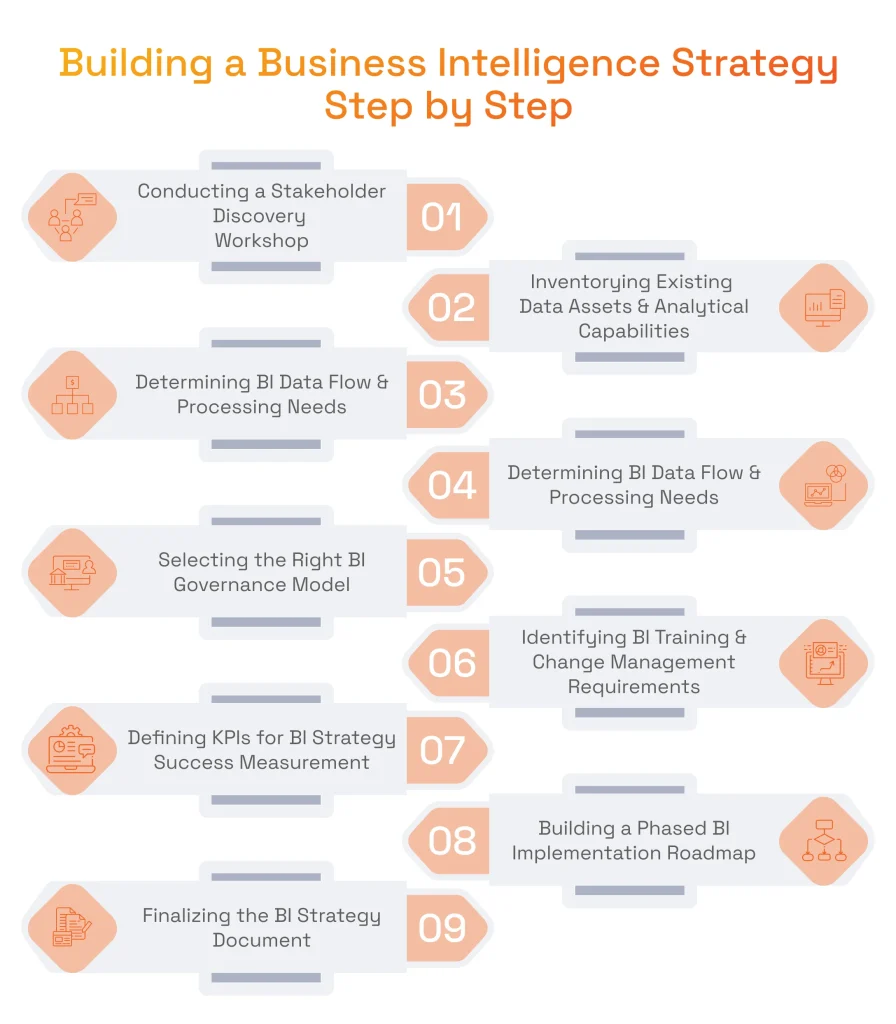
Step 1: Conducting a Stakeholder Discovery Workshop
The first thing to consider here is that BI strategy must always put business needs over any technological suggestions or trends. All stakeholders, including executives, department heads, analysts, and IT teams, should be involved with the goal of identifying potential challenges in data interactions and deciding what should be reported first. When done right, this step should result in a detailed stakeholder insights report summarizing BI expectations and principal business objectives.
Step 2: Inventorying Existing Data Assets & Analytical Capabilities
Next comes assessing the existing data infrastructure and determining whether it supports business goals. Using data audit helps identify where data is stored, its accuracy, and the effectiveness of existing reporting tools. The success at this step highlights gaps and the need for business intelligence in certain areas, and it ends up in the BI readiness assessment report.
Step 3: Defining BI Use Cases with ROI Projections
As for BI prioritization, all initiatives must be tied to the areas that generate the most business value. Use cases may include revenue optimization, operational efficiency, or fraud detection. Mapping these use cases to potential business impact ensures BI delivers measurable results, and the results of this step are documented by the BI use case roadmap being linked to BI initiatives.
Step 4: Determine BI Data Flow & Processing Needs
A well-defined data flow ensures a seamless transition from raw data to actionable insights. This step involves mapping data ingestion, transformation, and analytics processes while determining the need for real-time or batch processing. External data sources like IoT and market trends may also be integrated. The result of this step should be a BI data flow architecture diagram.
Step 5: Select the Right BI Governance Model
An effective governance model defines data ownership, security, and quality standards. There are options, as organizations can choose centralized governance for tighter control, decentralized governance for flexibility, or a hybrid approach that balances both. Establishing governance policies ensures data consistency and compliance, as by the end of this step, there should be a BI governance framework document.
Step 6: Identify BI Training & Change Management Requirements
BI adoption depends heavily on user proficiency with analytics tools. Rigorous training should include operating with BI dashboards, advanced analytics for data teams, and self-service BI capabilities for non-technical users. A strong change management plan ensures BI tools are used effectively, so after this step, there should be a detailed BI adoption and training plan.
Step 7: Define KPIs for BI Strategy Success Measurement
It is impossible to improve without the continuous tracking of BI performance. The key metrics organizations should pay attention to include saved time on reporting, the amount of data-driven decisions, or BI adoption rates, depending on a specific case. At the end of this step, there should be a BI performance dashboard that will help to refine strategy over time.
Step 8: Build a Phased BI Implementation Roadmap
A phased approach to BI implementation is a main factor in ensuring scalability and the initiative’s success in the long run. The initial phase establishes data governance and reporting foundations, followed by BI tool deployment, expansion to predictive analytics, and ongoing optimization. A structured timeline keeps all initiatives on track, as organizations should receive a BI strategy execution timeline spanning 6–24 months after this step.
Step 9: Finalize the BI Strategy Document
Finally, like with any innovation, it is critical to ensure the perfect alignment among all stakeholders. A comprehensive BI strategy document for leadership approval should outline business goals, BI architecture, governance policies, key use cases, and success metrics. This serves as a roadmap for execution and all future enhancements.
Common Challenges of Business Intelligence Strategies Development and How SPD Technology Overcomes Them
Even with the best business intelligence strategies, there are possibilities for some big challenges. In this section, we will talk about them and show how we typically solve the most common issues that arise when developing BI strategies for our clients.
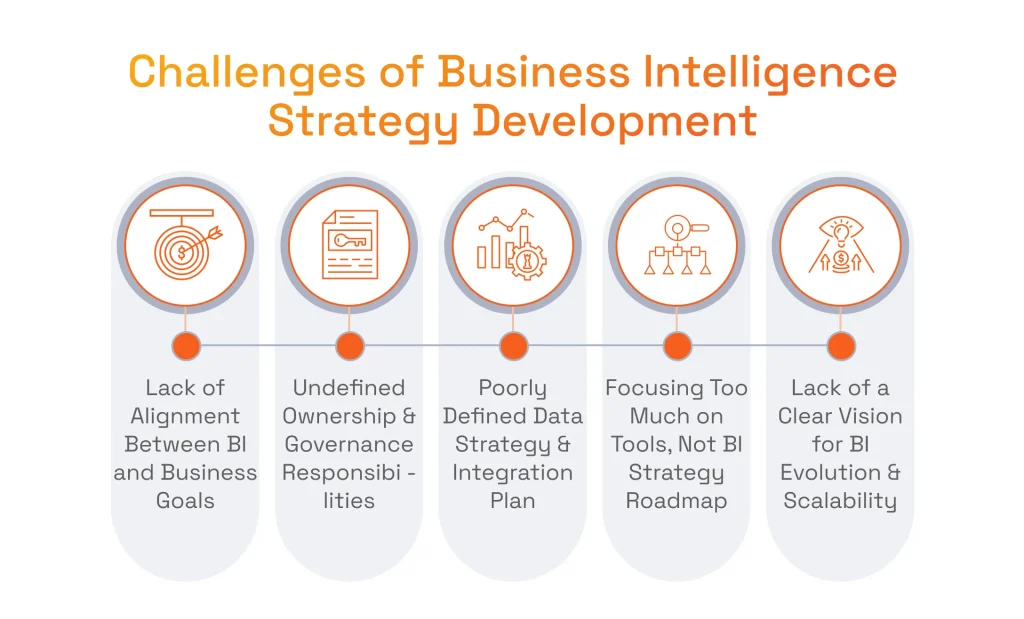
Lack of Alignment Between BI and Business Goals
Unfortunately, when business intelligence goals are focused more on data collection and reporting and not on alignment with the overall business vision, it becomes a problem. When BI initiatives are not driven by business needs, it will lead to low engagement and completely disconnected analytics efforts.
We, at SPD Technology, are ensuring this scenario will not happen because before selecting the tools and setting up an architecture, we define KPIs and measurable business metrics. This approach allows us to achieve tangible business impact, higher adoption efficiency and ultimately improve the decision-making process for our clients.
Undefined Ownership & Governance Responsibilities
Another blocker to efficiently adopting a business intelligence strategy is the lack or absence of defined data ownership and governance roles. This makes BI initiatives disorganized and inconsistent, resulting in inaccurate reporting and additional compliance risks.
We always develop a detailed framework for BI governance, setting data stewards and principal decision-makers responsible for data accuracy and security. It becomes one of the reasons why our BI ecosystems are trusted and accountable.
Poorly Defined Data Strategy & Integration Plan
The chosen data strategy may lack essential details, including the data structure and how information is stored and integrated. This may lead to data silos, inconsistencies of different scales, and an inability to grow.
We know how to use business intelligence, properly integrating data closely to your needs. Our experts know whether data lakes or data warehouses will best suit your specific case and will help you with ETL pipelines while creating a single, unified source of truth for critical information. This ensures that all the reports will be timely, correct, and adapted to changing business goals.
Focusing Too Much on Tools, Not BI Strategy Roadmap
There is also a quite widespread misconception about selecting tech stack and BI tools before finalizing business intelligence data strategy. By making this mistake, organizations will most likely waste their valuable resources on systems that will meet the current business needs but will be hard to scale from the long-term perspective.
Dmytro Tymofiiev
Delivery Manager at SPD Technology
“Our experts ensure long-term scalability by focusing on strategic goals and defining every aspect of the BI strategy roadmap before moving to picking the actual technological solutions. We leverage our expertise to deliver actionable BI solutions, not just fancy data visualizations with no actual value.”
Lack of a Clear Vision for BI Evolution & Scalability
The strategy an organization chooses to go with may cover the current needs and may seem holistic at first glance, but lack the potential to adapt to integrations with advanced technologies like Artificial Intelligence and machine learning. Ignoring this aspect puts the entire BI system in danger of possible need for redesigns, as it will fail to support added business units.
All of our BI roadmaps are phased with cloud-based scalability and the possibility of implementing AI features in mind. We will ensure that the goals of business intelligence will always be aligned with the business vision and bring in sustained innovation, helping to rise above competition.
Find out more about AI for Business Intelligence in our featured article, as we share our practical insights and how the latest trends already benefit organizations.
Why Implementation of Business Intelligence Strategy Requires a Pro Approach
Successful implementation of business intelligence strategies succeeds the essential integration of ready-made data analytics or marketing analytics tools and requires additional actions to ensure lasting success. Lacking a professional approach, your business intelligence initiative may be at risk of expensive mistakes and may require reworks.
Proficient BI strategy providers will help you build a scalable data infrastructure that will be capable of expanding your business and preventing any possible bottlenecks. Along with scalability, the speed of implementation is another deciding factor, and expert guidance can help you as well, with quick time to market and maximized ROI.
It is hard to overestimate the importance of data integration, and with a structured approach to business intelligence strategy, you will obtain a unified data source and avoid the common problem of data silos.
While working with operational and sensitive data, it is critical to ensure the highest level of security and comply with the security requirements of your specific industry, so your professional vendor should be skilled in security business intelligence best practices as well.
Partnership with a tech-savvy BI vendor also allows for unlocking AI-driven analytics. Combined with the business impact of Big Data, AI can introduce game-changing predictive and prescriptive features aimed at driving proactive business strategies.
Last but certainly not least is the fact that a strategic business intelligence partner can pace the adoption reasonably without rushing into development and making errors that could slow down the progress.
To help you find your perfect partner, we created a curated list of business Intelligence consulting companies, showcasing their expertise areas and the ways they can help your company step on a data-driven path.
Consider SPD Technology as Your Business Intelligence Roadmap Development Partner
With deep, cross-industrial technological expertise, we will become your most effective partner in developing a business intelligence roadmap that drives tangible value. Knowing how to take advantage of cloud computing infrastructure benefits, we are proficient in delivering scalable cloud BI architectures for supporting long-term perspectives and smooth data integration.
Dmytro Tymofiiev
Delivery Manager at SPD Technology
“Keeping our finger on the pulse of the latest innovations, we have a capable team of experts who are skilled in implementing AI-driven business intelligence tools. From predictive and prescriptive analytics to convenient chatbots, we can cover every aspect of AI for the benefit of your organization, as we did with many of our clients.”
We customize our BI solutions with intuitive dashboards, ensuring that all insights are perfectly matched with each client’s specific business KPIs and environments. By intensely focusing on data governance and regulatory compliance, we implement robust security frameworks that safeguard sensitive data and meet the highest industry standards.
Additionally, our commitment to continuous business intelligence performance optimization and support ensures that all analytics ecosystems of our clients remain efficient, scalable, and future-proofed.
Leveraging Strategic Business Intelligence: SPD Technology’s Success Stories
Let’s take a closer look at the implementation of business intelligence by our company, as we share the details of one of the recent case studies.
HaulHub’s Major Transformation in Transportation Construction Using AI and Data
Business Challenge
Our client is HaulHub, a leading B2B2C company that provides a digital platform for the transportation construction industry. The challenge was to overhaul and help the in-house team to add new components to their mission-critical platform. Key components included EDOT, DOT slip, SupplierCI, and AI/ML functionality.
SPD Technology’s Approach
To help our clients achieve critical goals and needs of the complex transportation construction ecosystem, we delivered mobile and web applications for the EDOT platform and successfully integrated all key stakeholders. The web platform was built using Java with Quarkus on AWS Lambda, enhanced with GraalVM for efficiency. The two native mobile apps were developed in Swift and Kotlin to achieve optimal performance, while a serverless API layer ensured scalability.
In the data engineering part of the project, we revamped the DOT Slip component, improving code quality and integrating internal and third-party data for seamless visualization. Scalable data pipelines and custom visualization tools were implemented using React.js, Chart.js, and Mapbox. SupplierCI development involved optimizing PostgreSQL with denormalization and caching, using AWS DMS and ETL processes for structured data integration.
As for the AI/ML part of the project, we used AWS Lambda for API development and integrated AI models, including OpenAI ChatGPT and AWS Bedrock for NLP, content generation, and recommendation systems, using a Retrieval-Augmented Generation (RAG) approach for enhanced chatbot interactions.
Value Delivered
- Development of the Critical Features: thanks to our expertise in data engineering, data quality management, and software development, we were able to deliver a set of features, including but not limited to digital inspection, live construction activity view, activation, and environmental product declaration reporting.
- Stable Integration with Third-Party Services: our experts were able to unify the platform with a broader ecosystem of transportation management tools by leveraging third-party services.
Our involvement in this project for transformation in transportation construction using AI and data resulted in a major success for our client. We continued this partnership, helping to refine the platform even further and reach the latest standards with our technological solutions.
Conclusion
The modern data-driven world turns a proper implementation of business intelligence strategy into a vital factor in the success of an organization. But the true power of modern BI lies in the professional integration of Artificial Intelligence, which helps to go one step beyond traditional approaches. By leveraging AI/ML, it becomes possible to open the limitless possibilities of powerful advanced analytics, automated decision-making, and detecting anomalies in real time.
Here, at SPD Technology, we offer exceptional business intelligence implementation strategy experience combined with profound machine learning expertise. We focus on delivering innovative, tailored solutions that transform the operations of our clients and build a competitive advantage out of historical and real-time data. Contact us today and find out how you can implement a successful business intelligence solution in your organization!
FAQ
What is Business Intelligence Strategy?
This is a structured approach to the process of collecting and analyzing valuable business information with the goal of improving critical business processes. A well-crafted business intelligence strategy clearly defines how a company gathers, processes, and presents information to turn it into a competitive advantage.
What Are the Key Components of a Successful Business Intelligence Strategy?
A thought-out strategy requires a set of critical components, including:
- Clear business goals
- Proper data governance and management
- Technology stack and infrastructure
- Data integration and accessibility
- Predictive analytics and reporting capabilities
- Employee training
- Performance evaluation and improvements.
How to Create a Business Intelligence Strategy?
A successful business intelligence strategy requires a strict approach, starting with clearly defining business goals. The next step is to assess current data resources and match them with the capabilities of business intelligence strategy. When this is decided, it comes to selecting the most appropriate tech stack and the right tools. After the creation of a framework for data governance, the integration of all data sources starts. Finally, it ends in designing BI dashboards and training staff for this innovation.

